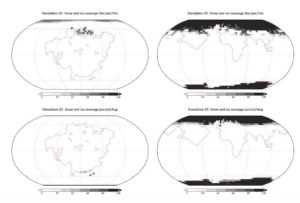
Long ago, all the continents were crammed together into one large land mass called Pangea. Pangea broke apart about 200 million years ago, its pieces drifting away on the tectonic plates — but not permanently. The continents will reunite again in the deep future. And a new study, presented today during an online poster session at the meeting of the American Geophysical Union, suggests that the future arrangement of this supercontinent could dramatically impact the habitability and climate stability of Earth. The findings also have implications for searching for life on other planets.
The study, which has been submitted for publication, is the first to model the climate on a supercontinent in the deep future.
Scientists aren’t exactly sure what the next supercontinent will look like or where it will be located. One possibility is that, 200 million years from now, all the continents except Antarctica could join together around the north pole, forming the supercontinent “Amasia.” Another possibility is that “Aurica” could form from all the continents coming together around the equator in about 250 million years.
In the new study, researchers used a 3D global climate model to simulate how these two land mass arrangements would affect the global climate system. The research was led by Michael Way, a physicist at the NASA Goddard Institute for Space Studies, an affiliate of Columbia University’s Earth Institute.
The team found that, by changing atmospheric and ocean circulation, Amasia and Aurica would have profoundly different effects on the climate. The planet could end up being 3 degrees Celsius warmer if the continents all converge around the equator in the Aurica scenario.
In the Amasia scenario, with the land amassed around both poles, the lack of land in between disrupts the ocean conveyor belt that currently carries heat from the equator to the poles. As a result, the poles would be colder and covered in ice all year long. And all of that ice would reflect heat out into space.
With Amasia, “you get a lot more snowfall,” explained Way. “You get ice sheets, and you get this very effective ice-albedo feedback, which tends to lower the temperature of the planet.”
In addition to cooler temperatures, Way suggested that sea level would probably be lower in the Amasia scenario, with more water tied up in the ice caps, and that the snowy conditions could mean that there wouldn’t be much land available for growing crops.
Aurica, by contrast, would probably be a bit beachier, he said. The land concentrated closer to the equator would absorb the stronger sunlight there, and there would be no polar ice caps to reflect heat out of Earth’s atmosphere — hence the higher global temperature.
Although Way likens Aurica’s shores to the paradisiacal beaches of Brazil, “the inland would probably be quite dry,” he warned. Whether or not much of the land would be farmable would depend on the distribution of lakes and what types of precipitation patterns it experiences — details that the current paper doesn’t delve into, but could be investigated in the future.
The simulations showed that temperatures were right for liquid water to exist on about 60% of Amasia’s land, as opposed to 99.8% of Aurica’s — a finding that could inform the search for life on other planets. One of the main factors that astronomers look for when scoping out potentially habitable worlds is whether or not liquid water could survive on the planet’s surface. When modeling these other worlds, they tend to simulate planets that are either completely covered in oceans, or else whose terrain looks like that of modern-day Earth. The new study, however, shows that it’s important to consider land mass arrangements while estimating whether temperatures fall in the ‘habitable’ zone between freezing and boiling.
Although it may be 10 or more years before scientists can ascertain the actual land and sea distribution on planets in other star systems, the researchers hope that having a larger library of land and sea arrangements for climate modeling could prove useful in estimating the potential habitability of neighboring worlds.
Hannah Davies and Joao Duarte from the University of Lisbon, and Mattias Green from Bangor University in Wales were co-authors on this research.
Note: The above post is reprinted from materials provided by Earth Institute at Columbia University. Original written by Sarah Fecht.










